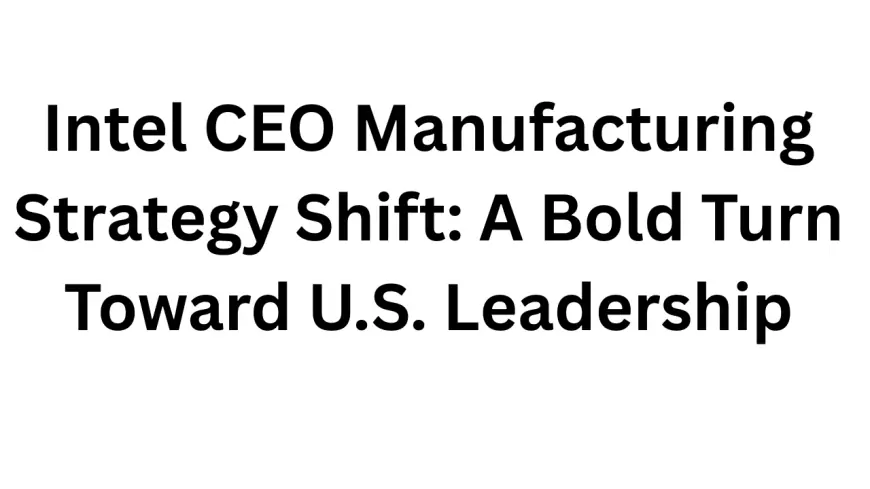Intel CEO Manufacturing Strategy Shift: A Bold Turn Toward U.S. Leadership
Explore how the Intel CEO manufacturing strategy shift is reshaping the global semiconductor landscape. Learn why Pat Gelsinger is doubling down on U.S. manufacturing, its impact on Intel’s competitiveness, and what this means for the chip industry’s future.

Introduction: A Turning Point for Intel
The global chip war is heating up, and Intel is no longer sitting idle. Under the leadership of CEO Pat Gelsinger, Intel has undertaken a major manufacturing strategy shift that aims to restore its legacy as a global semiconductor leader. With increasing geopolitical tensions, rising demand for chips, and supply chain vulnerabilities exposed by the pandemic, Intel’s new direction is both timely and strategic.
The keyword at the center of this transformation is clear: manufacturing not in Asia, but right at home in the United States.
What Is the Intel CEO Manufacturing Strategy Shift?
Intel's CEO Pat Gelsinger has introduced a bold multi-pronged plan focused on:
-
Rebuilding domestic chip manufacturing in the U.S.
-
Becoming a foundry for other companies, not just making chips for Intel products.
-
Investing heavily in advanced process nodes to compete with TSMC and Samsung.
-
Reducing dependency on overseas fabs, especially in Taiwan and South Korea.
This shift isn’t just a pivot in tactics it’s a redefinition of Intel’s identity in the modern semiconductor race.
Why This Shift Matters Now
1. Geopolitical Risks
With rising tensions between the U.S. and China, and Taiwan being a critical hub for chip production, Intel’s dependence on Asia-based supply chains became a serious risk. A regional conflict or even minor disruption could paralyze industries that rely on semiconductors, from automobiles to cloud computing.
Intel’s pivot to U.S.-based fabs mitigates that risk by securing more control over its production capabilities.
2. National Security and Economic Independence
The U.S. government has been vocal about the need for technological independence, and Intel's move aligns with this vision. The CHIPS and Science Act, passed by Congress, provides billions in subsidies for domestic chip production—an incentive Intel plans to capitalize on.
Intel’s manufacturing shift, therefore, is not just corporate strategy it’s national strategy.
Key Components of Intel’s Manufacturing Plan
Fab Construction in the U.S.
Intel has announced multi-billion-dollar facilities in Arizona and Ohio. These fabs are designed to support advanced process nodes such as 7nm and beyond. The Ohio facility, dubbed “Silicon Heartland,” is expected to become one of the largest semiconductor manufacturing sites in the world.
Intel Foundry Services (IFS)
This is a significant departure from Intel's traditional model. For the first time, Intel is opening its fabs to external clients, directly challenging dominant players like TSMC. Clients may include automakers, defense contractors, and even rival chipmakers.
Focus on EUV and Leading-Edge Nodes
Intel is investing in Extreme Ultraviolet Lithography (EUV), which is critical to compete with the world’s most advanced chipmakers. The goal is to reclaim technological leadership by mastering 3nm and smaller process nodes within the next few years.
Challenges Ahead for Intel
While the Intel CEO manufacturing strategy shift is bold, it is not without hurdles:
-
Execution Risk: Intel has struggled in the past with delays in its 10nm and 7nm rollouts. Gelsinger must rebuild confidence that Intel can deliver on time and at scale.
-
Cost and Capital: These new fabs cost tens of billions of dollars. Return on investment depends heavily on demand and long-term contracts with external clients.
-
Competition: TSMC and Samsung are years ahead in process technology. Catching up won’t be easy and will require flawless execution.
Market Reaction and Analyst Perspectives
The announcement of this strategic shift has been met with cautious optimism. Investors appreciate Intel’s proactive approach, especially in securing subsidies and forming partnerships. However, many are waiting to see if Intel can deliver results before regaining long-term investor confidence.
Industry analysts believe this strategy could eventually restore Intel's dominance but only if it maintains consistent progress over the next 5–7 years.
The Broader Impact on the Semiconductor Industry
Intel’s manufacturing strategy has ripple effects across the global semiconductor ecosystem:
-
Diversification of global supply chains, reducing Asia-centric concentration.
-
Increased pressure on TSMC to maintain pricing and innovation speed.
-
Incentivization for other U.S.-based players to expand domestically.
This transformation also supports government goals to bring back high-tech manufacturing jobs and reduce reliance on fragile overseas pipelines.
Final Thoughts: Intel’s Make-or-Break Moment
The Intel CEO manufacturing strategy shift is not a minor tweak it’s a top-down overhaul that signals Intel’s intention to reclaim its leadership position. By focusing on domestic manufacturing, advanced process technology, and a new foundry model, Pat Gelsinger is betting on a future where Intel is no longer a follower but a global leader once again.
Whether Intel succeeds depends on flawless execution, industry partnerships, and consistent innovation. If it works, this move could become one of the most important corporate turnarounds in tech history.
What's Your Reaction?
 Like
0
Like
0
 Dislike
0
Dislike
0
 Love
0
Love
0
 Funny
0
Funny
0
 Angry
0
Angry
0
 Sad
0
Sad
0
 Wow
0
Wow
0


















































